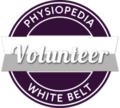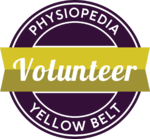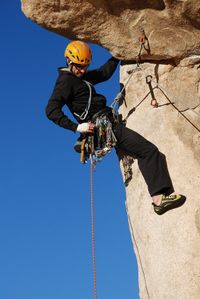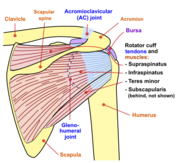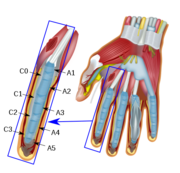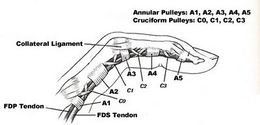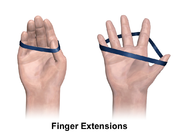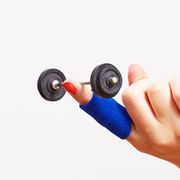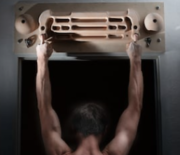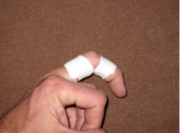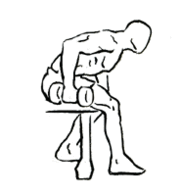Rock Climbing Injuries: Difference between revisions
Puja Gaikwad (talk | contribs) mNo edit summary |
Puja Gaikwad (talk | contribs) mNo edit summary |
||
| Line 1: | Line 1: | ||
<div class="editorbox"> '''Original Editor '''- Puja Gaikwad | <div class="editorbox"> '''Original Editor '''- {{User:Puja Gaikwad}} | ||
<div class="editorbox"> | <div class="editorbox"> | ||
'''Top Contributors''' - {{Special:Contributors/{{FULLPAGENAME}}}} | '''Top Contributors''' - {{Special:Contributors/{{FULLPAGENAME}}}} | ||
Revision as of 17:18, 19 September 2020
About Me[edit | edit source]
Dedicated and experienced Physiotherapist with three and a half years of clinical experience in evaluating and effectively managing patients of all age groups. I graduated from Maharashtra University of Health Sciences, India in 2017. Prevention, Diagnosis, and Treatment are my primary aim. My key areas of interest include injury prevention and management of various Musculoskeletal and Sports conditions. I particularly enjoy working on Prevention, load management, and return to sports with a view to assisting athletes or individuals in becoming self-sufficient with injury management.
Ready and qualified for the next stage in a successful career and looking forward to making a significant contribution as a “Physiotherapist.
Education[edit | edit source]
Bachelor of Physiotherapy (B.P.Th), Maharashtra University of Health Sciences, India (2017)
Diploma in Football Medicine- FIFA (April 2020)
Experience[edit | edit source]
- Clinical Physiotherapist at the HEAL Institute - Sports Medicine and High-Performance Center
- Junior Physiotherapist at Dr. L. H. Hiranandani Hospital
- On-field Physiotherapist at various football and cricket events, Marathons, etc.
Areas of Expertise[edit | edit source]
- Sports & Musculoskeletal Injury and Rehabilitation
- Orthopedic Manual therapy
- Functional Training
- Pilates
- Prehabilitation
- Gait Analysis
- Biomechanical/Postural Assessment
- Injury Prevention Techniques
- Ergonomic Assessment- workspace analysis.
Certifications[edit | edit source]
- Neuromuscular Dry Needling
- Kinesiology Taping
- Pilates- Gateway to core Stability
- Advanced Bobath and Adult Hemiplegia
- Advanced Cardiac Life support, ACLS
- Orthopedic Physiotherapy Course, OPC
- Strength & Conditioning Pre-Level 1 &2, World Rugby
Additional Coursework[edit | edit source]
- Sports Medicine: Understanding Sports Injuries - International Olympic Committee(IOC)
- Foundations of Pain by Modern Pain Care (AZPTA Approved Course)
- Pain Science and what you need to know - Clinical Athlete certified by ProCert (fsbpt)
- Essential Elements of Running-Association of clinical Excellence
- MAT online introductory module
- Sports-Related concussion training certificate
- Foundational Aquatic Therapy
- An Evidence-Based Approach to the Diagnosis and Management of Migraines in Adults in the Primary Care and General Neurology Setting by Stanford University School of Medicine
- Exercise Physiology: The Body in motion- IOC
- Absolute Speed- EXOs
Professional Affiliations[edit | edit source]
- Registered Physiotherapist- Maharashtra state OTPT council
- Member of Indian Association of Physiotherapist (MIAP)
- Member of International Association of Neuroscience (MIAN)
Physiopedia Contribution[edit | edit source]
So far have written articles on Rock Climbing Injuries, Dancer's Tendonitis, Exercise-Associated Muscle Cramps, Concussion Prevention Strategies, Heat Illness in Sports, Cold-Related Injuries, Finger Dislocation, Spring Knee, Overtraining Syndrome, etc.
Physiopedia Badges[edit | edit source]
Where you can find me[edit | edit source]
Top Contributors - Puja Gaikwad, Kim Jackson and Rucha Gadgil
Introduction[edit | edit source]
Rock climbing has become a professional competitive sport, many folks are being drawn to this sport with a parallel increase within the occurrence of sport-related injuries on both natural rock and artificial walls. It emphasizes on physical and mental challenges, one that often tests climber's upper and Lower body flexibility, strength, endurance, agility, and balance along with mental control. It is a popular sport with the explosion in climbing gyms, bouldering venues and bolted sports routes.
Excessive loading of the upper extremities , contorted positioning of the lower extremities, rockfall, and falling from height create an elevated and diverse injury potential that's hampering experience level and quantity of participation. Injuries can range from acute traumatic to chronic overuse injuries. Unique sport-specific injuries to the flexor tendon pulley system exists, but the remaining Musculoskeletal conditions aren't exempt from these type of injuries.[1] Understanding the techniques of rock climbing and its injury patterns, treatments, and prevention is important to diagnose, manage and counsel the rock-climbing athlete.
Risk Factors [edit | edit source]
1. Age
2. Higher skill (difficulty) level
3. high CIS (Climbing Intensity Score)
4. Poor climbing movement pattern:
- An example of climbing inefficiently with bent elbows- This increases the stress on biceps.
- Climbing with elbows in a chicken wing- This puts excessive stress on shoulder joint and is a result of latissimus dorsi and shoulder internal rotators working too hard.
- Too much wrist flexion and can compress the joint and nerve in the wrist as well as lead to elbow pain.
5. Participating in lead climbing
6. Using inadequate climbing equipment’s
7. Improper footwear- shoes that are too small and tight
8. Climbing in bad weather condition
9. Over-training lead to a number of overuse and traumatic injuries.
Prevalence and incidence of injuries[edit | edit source]
Studies that have estimated the prevalence of injuries associated with rock climbing vary between 10% and 81% irrespective of cause. between 10% and 50% for impact injuries, between 28% and 81% for non impact acute trauma injuries and between 33% to 44% for chronic overuse injuries.[2]
Mechanism of Injury[edit | edit source]
Climbing above ones's skill level, the weight of a climber places an extensive amount of stress not only on their fingers, but also on their wrists, elbows, and shoulders.
- Inherent within the characteristic of sport, climbers frequently subject their bodies to recurrent traumatic forces, whether from throwing to succeed in holds (denoting and dead pointing) or falling from climbs (especially with bouldering), which leads to either acute or overuse injuries.
- This apparent pattern of overuse injuries may be associated with the architecture of climbing walls, climbing techniques, specific training , or relative weakness of specific group of muscles.
Injuries in rock climbers[edit | edit source]
Climbing-related injuries may be categorized as:
- Impact injury caused by the climber falling onto a climbing surface and/or ground, or an object, such as a rock falling on to the climber.
- Non-impact injury resulting from acute trauma to the body.
- Chronic overuse injury from repetitive climbing.
A survey conducted shows, the majority of injuries (82%) were categorized by the respondents as overuse injuries. Upper extremity injuries were the vast majority and accounted for 63% of all injuries. Hand overuse injuries predominated (28% of all injuries), although elbow injuries were a close second (19%). Combined upper extremity overuse injuries were common. Consideration of the anatomical distribution of injuries associated with rock climbing may be useful in an injury prevention and in rehabilitation of the injured climber.[3]
The most common injuries seen in rock climbers are:
Upper Extremity[edit | edit source]
Sport rock climbing with it's repetitive high-torque movements in gaining the ascent of a rock face or wall, often in steep overhanging positions, is associated with a unique distribution and form of upper limb injuries.[4] Injuries of upper extremity are often among climbers (Folklores, 2013). They vary from light abrasions , through more severe like SLAP Lesion ,Flexor digitorum tendon pulley injury, rotator cuff tears; to bony fractures like hamate fracture and phalangeal epiphyseal stress fracture. The most often injured part of upper extremity is flexor digitorum tendon pulleys (Bayer and Schweizer, 2009: Blanchette et.al. 2015; Chang et al. 2016; Crowley, 2012; Desaldeleer and Le Nen, 2016; Lutter et al. 2016; Merritt and Huang, 2011)
Shoulder injuries in climbing[edit | edit source]
The shoulder typically accounts for 17% of all climbing-related injuries. Sport climbers and boulders are particularly susceptible to the development of shoulder injuries due to prolong repetitive upper limb movements on vertical or overhanging terrain. A cross-sectional cohort study of 201 climbers found the shoulder injuries to be related to the frequency and difficulty of indoor and outdoor sport climbing and bouldering. [5] An analysis of an injury trends in sport climbing and bouldering over 4 year period found superior labra anterior posterior tears and impingement of subacromial structures to be the common diagnosis in most of the climbers.
Subacromial Impingement[edit | edit source]
The unique physical demands associated with climbing, as well as a reported 33-51% incidence of shoulder injuries in these athlete is suggestive of abnormalities in scapulohumeral biomechanics .[6] Clinically climbers with shoulder and arm symptoms are commonly observed with poor scapulothoracic and Glenohumeral control (Kibler et al. 2013). Scapula positioning on the thorax is important in order to create a stable base for shoulder movement and maintain humeral head in the centre of the glenoid (Mottram 1997). If the scapula is not moving properly, the shoulder joint will have to pick up the slack, this puts climber at an increased risk of impingement.
Often most of the rock climbers shows relative weakness of shoulder external rotators (Trees minor and infraspinatus). These muscles are a part of a rotator cuff located on the dorm of scapula. It helps to stabilize the glenohumeral joint during upward reaching. This muscular imbalance create a high risk of shoulder impingement.
Rotator Cuff Injuries[edit | edit source]
These injuries are common in rock climbers because of the amount of time they spent with their arms overhead pulling up their body weight. The rotator cuff provides stability for the shoulder. It's comprises of tendons that attaches to the humerus, as well as the four major muscles that surround the shoulder complex. A weak rotator cuff and/or altered biomechanics can contribute to a tear o tendonitis. Common symptoms include pain, weakness on lifting a heavy objects or lowering the arm, restricted range of motion, and hearing clicking or popping sound.Physiotherapy Management[edit | edit source]
Conservative treatment can be effective in treating tendonitis and partial tears. This includes relative rest, ice, anti-inflammatory medications, corticosteroid injects, and physiotherapy. Exercise program will focus on activating the appropriate muscles during climbing, then progressively strengthen them to improve performance and minimize the risk of injury in future.
Rotator cuff strengthening : For a shoulder, exercise to be effective it must be functional. There are two exercises which are found to be effective.
- Wall clock: It strengthens rotator cuff muscles by simulating the action of reaching for climbing holds in varied positions.
- Looped Band Reaches: It strengthens and stabilizes the shoulder in a range of motion that is required to have during climbing. How to do: Wrap a single resistance band around west. Sit into a mini squat to mirror the position of the lower limb when climbing. Press outwards on the band and raise the arms overhead.
- Robber *Scapular retraction
- Windmill *Scapular retraction
- Bent over I, T, Y
- Rows
- Hanging Scapular retractions
- Pull-ups:
- Weight assisted with band
- Shoulder width
- offset or wide: This position increases the likelihood of impingement, progress to this only the pain-free in the easier version of push ups.
9. External rotation with a band, weights, etc.
10. Shoulder blade repositioning- Rigid taping can be done in case of scapular dyskinesia.
If symptoms don't go away or there is a complete rotator cuff tear surgery may be necessary to repair the tendon. Research has shown favorable outcomes after an arthroscopic repair in climbers that will allow most athletes to return to or near their pre-injury level of climbing. Thus, surgery is a valid treatment for climbers with acute traumatic tears and those with chronic tears who fail to respond to conservative treatment.[7]
Elbow injuries[edit | edit source]
Lateral epicondylalgia (Commonly referred to as tennis elbow) is a very common elbow injury. This is caused by excessive forces on the lateral elbow due to increased muscle overuse of extensor forearm muscles. Symptoms include pain at the outside of the elbow aggravated by repetitive gripping activities.
Physiotherapy Management[edit | edit source]
Treatment may include the following:
- Relative rest
- Ice, anti-inflammatories
- Bracing (Forearm counter-force brace, wrist anti-extension brace). These braces help off load the muscles that attach to the elbow, decreasing the excessive pulling on the area and allowing it to heal quickly.
- Unloading taping (diamond taping)
- Myofascial release techniques to the wrist extensors
- Gradual strengthening of wrist extensors (concentric and eccentric) using weights and flexibar.
- Progressive return to climbing.
*A note on corticosteroid injections: injection appears to have superior short-term outcomes however, physiotherapy treatment is more effective in the intermediate to long-term than injection or "wait and see" alone.
Hand Injuries[edit | edit source]
Based on recent series >75% of elite and recreational sport climbers are reported to have injuries at upper extremities, and up to 30% of them have specific signs of flexor pulley system rupture with the loss of strength across the full range of motion of finger, decrease Ange of motion and bowstringing.[8]
Clinically Relevant Anatomy[edit | edit source]
As shown in the picture, The four- long white, rope-like structures are tendons that helps in gripping and curling of fingers. These are secured to the bones below by circular structures called "Pulleys". There are five pulleys on the palm side of each finger. The A2 pulley is located in the first finger of proximal phalanx closet to the palm.
Annular Pulley injury[edit | edit source]
One of the most common and unique lesions occurring in the rock climbing population is the closed rupture of the flexor pulley system of the fingers due to Closed-hand crimping. An A2 pulley strain is the most common finger injury for climbers and most frequently occur in the ring or middle finger. These injuries can vary from a mild strain or a complete tear. This type of injury is strictly associated with some climbing techniques in which the hole body weight is placed on finger holds, which causes bowstringing of the flexor tendons with subsequent loss of strength across the complete range of motion of the finger and this places 3-4 times more stress on A2 pulley than at the fingertip.
Overusing full crimps weakens pulleys, making them susceptible to breaking because of the position of A2 and A4 pulleys, along with the force ratio of the two finger flexor tendons, a crimp position applies a strong "bowstring" tension on to them. This combination with a near maximum contraction of two tendons exerts a bowstringing (bulging) force outwards, pushing and stretching the pulleys. These forces may add up to reach a point threshold and then a tear, train or rupture can occur.
Grades of injury[edit | edit source]
There are four different levels of flexor pulley injuries:
Grade I: Strain
Grade II: Partial rupture
Grade III: Single pulley rupture
Grade IV: Multiple pulley rupture
Generally, grade I-III are treated conservatively with initial immobilization and early functional therapy under pulley protection.
- Grade I-II usually can achieve full recovery in 6 weeks, should continue protective taping for 3 months following an injury.
- Grade III should be immobilized in a splint for 10-14 days, protective taping for 6 months following an injury. Can return to gentle climbing at 6-8 errs, with full climbing at three months.
- Grade IV injuries (multiple ruptures) require surgical repair.
Clinical Presentation:[edit | edit source]
Climbers usually present with pain and tenderness on the palmer aspect of finger and an audile "pop" could also be reported at the time of injury along with swelling and bruising, impaired grip strength. Sometimes a visible bowstringing of the tendon can be seen away from the finger bones if the sheath is completely ruptured. The A2 and A4 pulleys modulate force transmission during finger flexion. Therefore, loss of A2 or A4 pulley may result in a permanent, or significant strength loss.
Preventive measures[edit | edit source]
Her are some guidelines to follow and Lower the risk of rupturing a pulley.
- Open Hand Crimp: Crimping with an open hand will decrease the stress directing on fingers and distribute the force evenly.
- Warm ups that raises body temperature, contracts climbing muscles, moves the torso, arms and hands
- Body awareness and paying attention to your body and hand positions on holds and before "bearing down"
- Vary hand holds after attempting strenuous hand positions.
- Be prudent with twisty moves, try to move body with the twist instead of all twist into the finger, if possible.
- Kinesio taping
Physiotherapy Management[edit | edit source]
A physiotherapist can assist in the diagnosis and treatment of flexor pulley injuries. Treatment will vary depending on the severity of an injury.
Generally, a diagnosis is determined by the following:
- Mechanism of injury : The most likely cause of injury is a fall or slip with crimp grip sometimes with a corresponding loud pop at the time of injury. These injuries usually have an acute onset versus overuse.
- Symptoms: Pain, swelling, bowstringing (seen while multiple pulleys are damaged)
- Imaging: Dynamic Ultrasound is the gold standard for identifying flexor tendon injuries.
Treatment approach for Grade I & III Pulley injury:[edit | edit source]
- Relative rest, icing and splinting is recommended.
- Finger Extensor Exercises: Overused finger flexors can lead to weakness of the finger extensors, which help to stabilize fingers while climbing. so it's important to perform finger extensor strengthening exercises to prevent pulley injuries.
- Perform isometric holds at multiple angles to mire the muscle action of finger while climbing. perform 3 sets of 30 seconds.
- Taping: After healing, taping can also be done to provide additional support while climbing.
Post-Operative rehabilitation after flexor tendon pulley repair[edit | edit source]
The goal of the rehabilitation phase process is from pain, inflammation and tissue overload stage to achieve full mobility, strength and eventually pain-free climbing movement.
Early stage[edit | edit source]
The first stage of injury is controlling inflammation and it is traditionally done by relative rest' icing, and taping as a form of protection from day to day activities. Climbing is not advisable at this stage.
Hand Strengthening:
- Gripping: Start using a soft "stress ball", sponge or easy grip tool using all fingers and thumb hold, squeeze and the release, later add isometric holds as a progression and then do with a resistance grip tools like Theraputty.
- Pinching: Working on pinch strength is essential for climbing activity. keep thumb and fingers straight, place the ball on the tips of digits, gently squeeze all together, visualizing a tension build up in the hand. Also visualize that having a small ball in the centre of palm. later progress this exercise using finger springs.
- Rubber- Band Finger Extensions: Place an elastic band around the PIP joint of fingers and thumb and then try to open finger against the band away from each other.
Mid-Stage Rehab[edit | edit source]
- Soft-tissue release : Releasing tightened structures like forearm flexors and intrinsic muscles of hand.
- Weighted Finger Curls: It is also important to start this exercise using first three digits together as a warm up. Later progressing to individual strengthening of an injured finger
- Stretching: stretch fingers and forearm flexor muscles to maintain elasticity of the muscles.
End stage Rehab[edit | edit source]
- Finger Board Exercises :Static dead hangs on a fingerboard is a great way to rehabilitate after early and mid-stage rehab exercises and tests are pain free and strong. It is best to start open handed them once exhausted the possibilities and combinations with open handed, try static hangs with half crimp. The safest way to start finger/campus board training is to begin with feet on dead hangs, then hang and reach with feet/foot on, them feet off dead hangs, pull ups and hang and reach.
- Pull ups
- Taping: The H-taping method decreased the tendon-bone distance in the injured finger significantly by 16%. the strength development was significantly better with the new tape for the crimp grip position (+13%), but there was no significant improvement for the hanging position. It reduces the tendon-bone distance and provides more stability to pulleys. It is more effective than circular taping. [9]
Return to climbing[edit | edit source]
Criteria and assessment test before returning an athlete to climbing needs to be specific to the type of climbing that the patient does, the level, and frequency.
- No pain with any sort of gripping/pinching/crimping with hand tools
- Equal weight of single finger curls for right/left fingers (injured finger and same finger of other hand, using no more than a 5 kg weight).
- Pain free static dead hangs on fingerboard (start open handed then half crimp using front 3 then back 3 in all variation of positions, then front 2 back 2)
- Campusing with good technique if an athlete used to do campusing before an injury. Starting open handed then with half crimp if they feel its often required. Good composing technique is crucial. It is important to have a strong core, especially obliques, and use hips to initiate movements.
- if an athlete returning to hard bouldering, or hard sport climbing make sure they perform the same, or better on a fingerboard than have done in the past.
Collateral ligament strains[edit | edit source]
This type of injury commonly occur with sideways loading, such as when throwing one hand out to a hold with the other. It most commonly occurs in the PIP joint of middle finger. Symptoms include pain, swelling, and tenderness around an injured finger. Treatment for this type of strain is usually conservative and relative rest, ice, anti-inflammatory medications, and taping the finger for support.
Wrist injuries[edit | edit source]
The most common wrist injury in climbers occur when there's a damage to Triangular fibrocartilage complex (TFCC). It provides stability and support when the hand clenches or the arm rotates. when an athlete feels the onset of wrist pain and continues to climbing pushing through his limits, TFCC can go under degenerative and can even tear. Symptoms include a dull, achy pain on the side of the wrist and sometimes a throbbing pain is felt when flexing a hand towards the 5th digit. when diagnosed early, relative rest, anti-inflammatories, and a splint can typically heal this type of injury. After healing, taping the wrist while climbing can help provide an additional stability and support to prevent re-injury. In more severe cases, surgery is essential to get rid of the damaged tissue and clean the torn edges; this is also referred to as debridement. Recovery from this procedure include wearing a cast for several weeks followed by physiotherapy to regain range of motion and strength.
Lower Extremity[edit | edit source]
Traumatic injuries (eg. falls) accounted for 18% of injuries and predominantly affecting lower limbs.[10]
Knee injuries[edit | edit source]
Less intuitively, knees are also common areas of injury for rock climbers. The repetitive stress from falling during bouldering sessions can easily cause damage of meniscus, or any of the tendons or ligaments within the joint. These same connective tissues are also strained during regular climbing positions if climbers do not have sufficient hip flexibility. Toeing down or edging on small holds with hips open and heels raised can cause abnormal forces exerted on the knees. Drop knees (inward rotation of hip while maintaining leg tension) can cause large amount of stress on the knee, resulting in injuries as minor as bursitis (inflammation of bursa) or as severe as dislocated patella.
Ankle injuries[edit | edit source]
Due to the recurrent falling inherent with climbing (whether during bouldering or roped climbing), ankles are often in danger for sprains and fractures, especially with the soft and flexible shoes used for climbing. Learning proper falling and landing techniques are necessary for prevention, as well as careful spotting and belaying of others.
Quick Stats[edit | edit source]
- Injury rates in lower extremities are low and are often caused by trauma.
- Females more likely to report injuries in shoulder/arm and more likely to undergo surgery for injury compared to males.
- A past injury is a significant risk factor for re-injury, particularly at the site of fingers.
- 51.1% of climbers return to climbing before their injuries are healed, and 44.9% have chronic problems associated with their climbing injury.
Injury Prevention[edit | edit source]
While rock climbing injuries are common, they are not unavoidable. These are steps which may be take to reinforce climbing performance and health. Prevention should start with educating climbers's on the potential risk for injury. Although adequate rest in between the climbs and reduced training them pain is first encountered would aid in alleviating numerous problems. Early changes in climbing schedules, stretching and exercise habits, and protective taping are necessary to prevent an injury in these climbers.
Warm Ups[edit | edit source]
Lack of warm-up can increase the likelihood of an injury. A thorough warm-up increases blood flow, muscle flexibility, and body control and it will activate all of the essential muscling used for climbing activity. A 2016 study of handball player by (Andersson et al.) showed that a comprehensive warm-up program can decrease injury rates by up to 28&. A complete warm-up includes four components, all to be performed in the following sequence:
- Increase blood flow
- Improve Mobility
- Stability exercises
- proprioception
1. Increase blood flow with aerobic exercises for 5-10 minutes to elevate deep-muscle temperature, which makes the muscles more adaptable and lessen the risk of strain or tear
2. Improve mobility with dynamic stretching and it's proven to be the best choice. Research supports that a sport specific dynamic warm-up is the best way to increase blood flow to the muscles and tendons in the body. This method prepares the body for a selected activity and may help reduce injury rates.
Dynamic warm ups include:
- On The Wall
Uses the entire body to generate warmth. It mirrors specific body positions that are used while climbing.
How to do : Flex your hip up towards the chest. grab knees and pull to towards the chest and then release back down to the floor.
- Rotation
Uses rotational movements to warm-up the muscles. This often overlooked stage and it's extremely important in climbing due to the rotational nature of the sport.
- Arms
Uses dynamic stretching to warm a primary muscle an it's opposing muscle during a single motion.
- Wrist and Fingers
Targets the smaller muscle groups with tendon glides.
3. Target stability with muscle-activation exercises:
For injury prevention train antagonist muscles of fingers and wrist extensors, shoulder rotators and scapular muscles along with dynamic stretches which give a foundation for injury-free climbing experience. Training antagonist muscles can improve posture and reduces pain.
- Strengthening exercises includes-
Isometric bent over T, Eccentric triceps extension, Core training, Hanging pike ups, Pull ups, Plank knee-to-Elbow etc.
[12]- Weight training : includes single leg heel raise, Shoulder press, Bulgarian split squats etc.
4. Proprioception training for stability can be performed including exercises like:
- Foot Stabbing:
Stand on the ground, about an inch away from the climbing wall. Make sure there are low foot Chips to use. Slowly begin leaning forward until getting to tipping point and feel like falling over. Immediately stick a foot out to any of the foot chips on the wall to catch yourself. Target how close foot was to landing right on top of the foot chip. It's difficult to consistently get the foot in proper position on the hold.
- Blinking:
Try this as you climb up or down a route. As an athlete climbing, check the next foot hold. Before moving the foot to that hold, then try closing eyes all the way until the foot is on the new hold. Repeat this for each foot hold ups route. Then try to progress it by doing with the hands
- Begin climbing with a gradual increase in route difficulty.Begin climbing with a gradual increase in route difficulty.
References[edit | edit source]
- ↑ Cole, Keegan P. MD; Uhl, Richard L. MD; Rosenbaum, Andrew J. MD Comprehensive Review of Rock Climbing Injuries, Journal of the American Academy of Orthopaedic Surgeons: June 15, 2020 - Volume 28 - Issue 12 - p e501-e509 doi: 10.5435/JAAOS-D-19-00575
- ↑ Jones G, Johnson MI. A critical review of the incidence and risk factors for finger injuries in rock climbing. Current sports medicine reports. 2016 Nov 1;15(6):400-9.
- ↑ Neuhof A, Hennig FF, Schöffl I, Schöffl V. Injury risk evaluation in sport climbing. International journal of sports medicine. 2011 Oct;32(10):794-800
- ↑ Holtzhausen LM, Noakes TD. Elbow, forearm, wrist, and hand injuries among sport rock climbers. Clin J Sport Med. 1996;6(3):196-203. doi:10.1097/00042752-199607000-00010
- ↑ Jones, Gareth PhD1; Schöffl, Volker PhD1,2,3,4; Johnson, Mark I. PhD1 Incidence, Diagnosis, and Management of Injury in Sport Climbing and Bouldering: A Critical Review, Current Sports Medicine Reports: November 2018 - Volume 17 - Issue 11 - p 396-401 doi: 10.1249/JSR.0000000000000534
- ↑ Roseborrough A, Lebec M. Differences in static scapular position between rock climbers and a non-rock climber population. North American journal of sports physical therapy: NAJSPT. 2007 Feb;2(1):44.
- ↑ Simon M, Popp D, Lutter C, Schöffl V. Functional and sports-specific outcome after surgical repair of rotator cuff tears in rock climbers. Wilderness & Environmental Medicine. 2017 Dec 1;28(4):342-7.
- ↑ Robert Pedowitz, Christine B. Chung, Donald Resnick,Magnetic Resonance Imaging in Orthopedic Sports Medicine,google books, 2008
- ↑ Schöffl I, Einwag F, Strecker W, Hennig F, Schöffl V. Impact of taping after finger flexor tendon pulley ruptures in rock climbers. Journal of applied biomechanics. 2007 Feb 1;23(1):52-62.
- ↑ Maitland M. Injuries associated with rock climbing. J Orthop Sports Phys Ther. 1992;16(2):68-73. doi:10.2519/jospt.1992.16.2.68
- ↑ Dynamic climbing Warm-up Available from: https://youtu.be/B86QxHCDiM0
- ↑ Rock climbing fitness tests- Hanging pike, 2 Rep Pull Up, and 20 mm Edge Dead-Hang Available from: https://youtu.be/hCkJEM2L3j0

